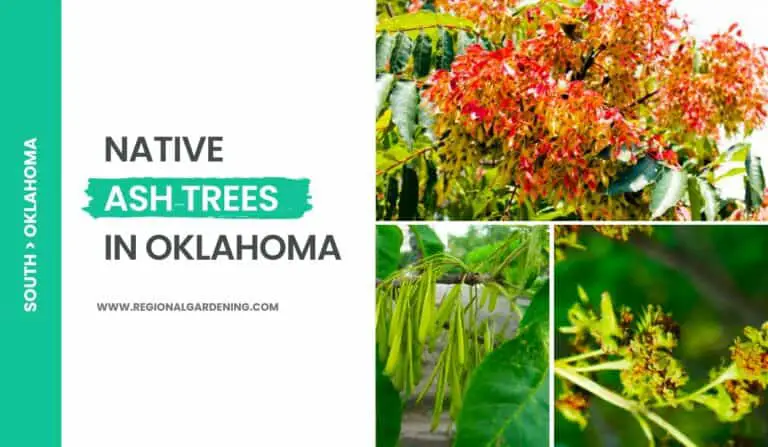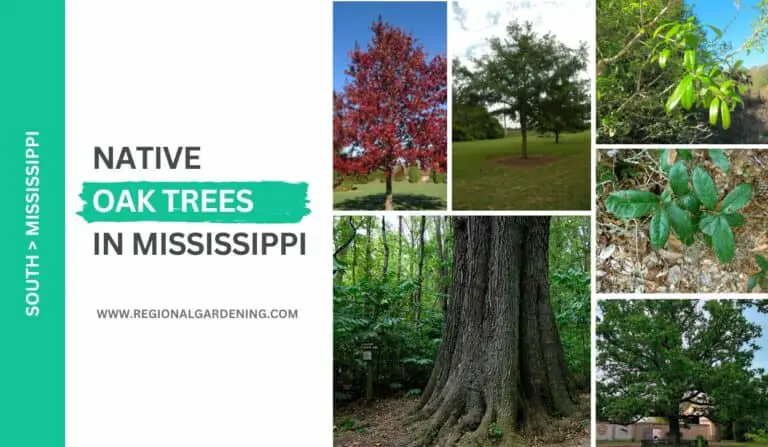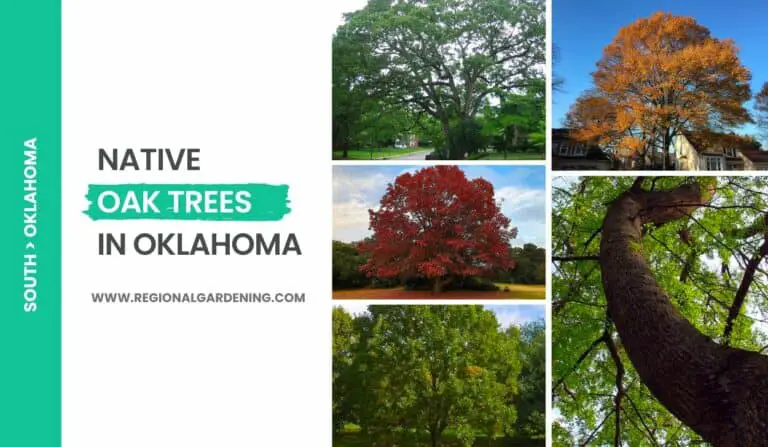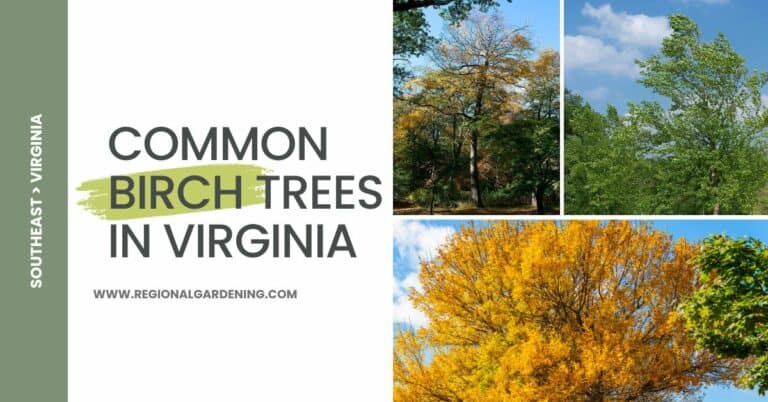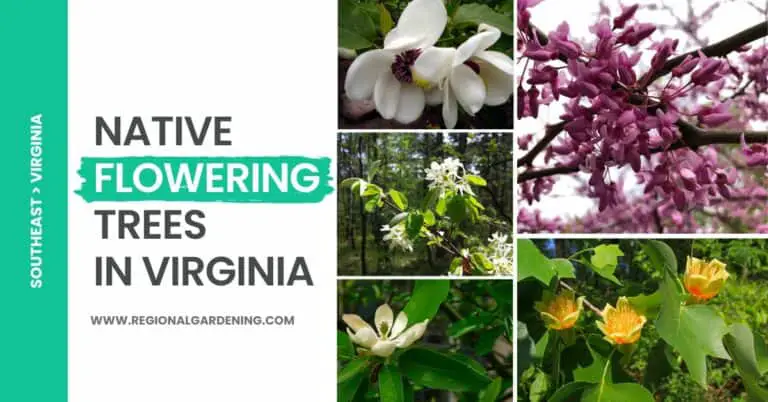7 Types Of Native Hickory Trees In Georgia (With Photos)
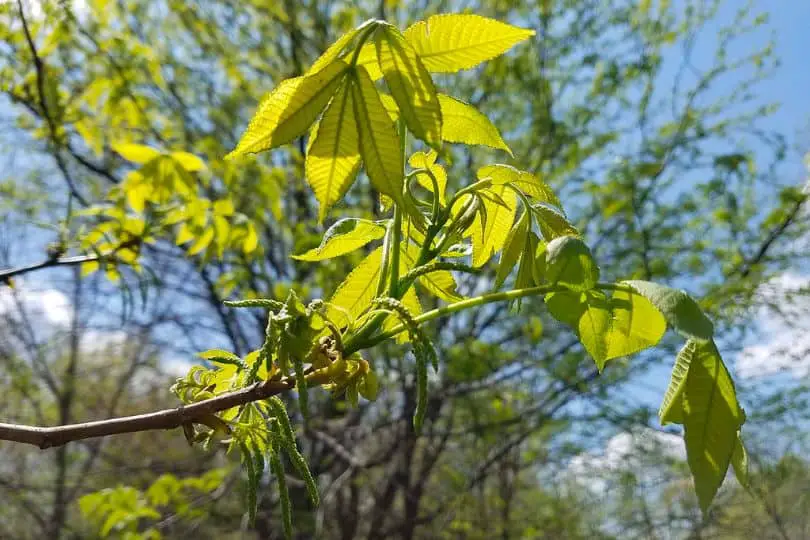
In the lower south and southeastern states, like Georgia, hickory is one of the most common forest nut trees. And, if you are looking for a complete identification guide that walks you through all the native hickory trees in Georgia, then this is the right place to be.
I’ll show you 8 of the most common types of native hickory, along with pictures, ways to tell them apart, where they grow, where they come from, and what they can be used for.
So, let’s get started.
1. Bitternut Hickory

The bitternut hickory tree can reach a height of 100 feet with a trunk diameter of 2 to 3 feet. The tree’s compound leaves, which are 6 to 10 inches long and comprise 7 to 9 slender, long-pointed leaflets, fall off in autumn.
The leaflets have toothed borders except at the base and are smooth and dark green on the upper surface, while the underside is lighter and hairy. The petioles or stems are hairy and thin.
The Bitternut Hickory tree yields cylindrical or slightly flattened fruit that is about three-quarters and one-and-a-half inches long and has four wings at the end. The fruit’s thin, hairy hull is covered with tiny, golden scales.
Inside the fruit are an oblong, flattened, grey or light reddish-brown nut with a thin, brittle shell and a bitter kernel. At first, the bark of the tree is smooth and light brown with a hint of red. Later, it gets shallow furrows and thin, interwoven ridges. The surface of the bark is slightly scaly and it is tight and firm.
The Bitternut Hickory tree has various distinguishing features, including a fruit with a winged hull, a nut with a thin, fragile shell, and a bitter kernel. Moreover, the tree develops flat, sulfur-yellow, and hairy winter buds.
The wood of the Bitternut Hickory tree is dense, durable, heavy, densely-grained, and sturdy. It shares the same dark brown hue as other hickory woods. On the piedmont, the Bitternut Hickory is usually found in mountain valleys, along streams, and in marshes. However, it is uncommon in the coastal plain.
Like other hickories, this tree has many uses, such as making furniture, handles for tools, and firewood.
2. Red Hickory
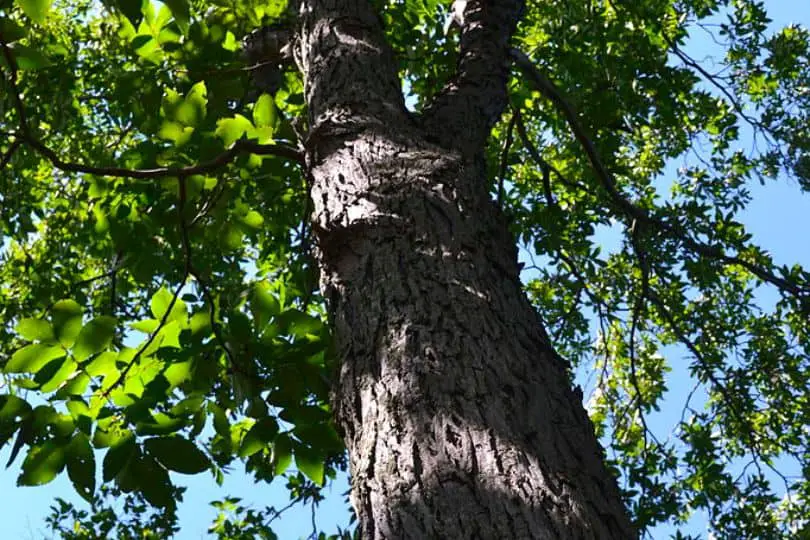
The Red Hickory, also known as the False Pignut Hickory, is a deciduous tree with complex leaves that are 8 to 10 inches long and have 5 to 7 oval to narrow leaflets. The leaves are dark green and smooth above and below, with serrated margins. The petioles, or stems, are smooth as well.
The Red Hickory tree can reach heights of 80 to 100 feet and has a trunk diameter of 2 to 3 feet. It has a pyramidal, thin head. The Red Hickory tree has comparable leaves to the Pignut Hickory, small fruit (1 to 1 1/4 inches long) with a thin husk (1/12 to 1/10 inch thick) that splits freely to the base, and somewhat scruffy bark.
The tree produces oval-shaped fruit that measures 1 to 1 1/4 inches in length. The husk of the fruit is thin and easily splits to the base. The nut inside the fruit is usually brownish-white and silky. The bark has a pale grey color that divides into thin, plate-like scales and has a shaggy appearance.
The Red Hickory tree’s wood is heavy, robust, tough, flexible, and brown. It is extensively used in the manufacture of tool handles, agricultural implements, and fuel. The tree grows on fertile soils, usually on hillsides in the state’s central region.
3. Mockernut Hickory
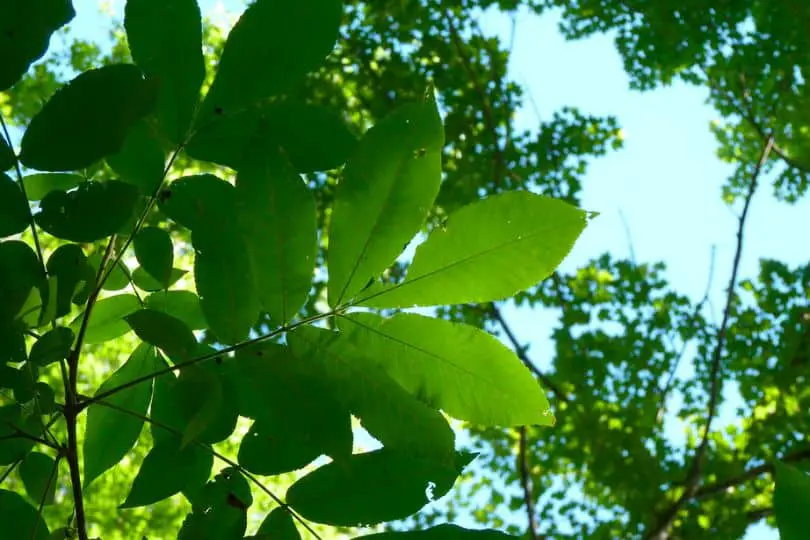
The Mockernut Hickory, which has the scientific name Carya tomentosa Nutt., is a tree that loses its leaves in the fall. The leaves are made up of 7 to 9 small leaflets and are 8 to 12 inches long (rarely 5). The leaflets smell good and have teeth. The leaflet at the end is 4 to 6 inches long and 2 to 4 inches wide, while the ones on the sides are only 2 to 4 inches long and 1 to 2 inches wide. The upper side of the leaves is shiny and dark yellow-green, while the underside is hairy and light yellow-green to orange-brown. The leaf stems, called petioles, are also hairy.
The tree grows oval or almost round fruits that are 1 1/2 to 2 inches long and have a dark red-brown hull about 1/8 inch thick. When the nut is ready, the hull splits almost to the bottom, revealing a light brown nut with a thick, hard shell. The sweet part of the nut is the kernel.
The bark of the Mockernut Hickory is dark, hard, and close, with low, round, intertwined ridges and shallow furrows. The tree usually grows to less than 100 feet tall, and the trunk can be up to 3 feet in diameter. The tree’s crown can be thin and pointed or wide and round.
The Mockernut Hickory has hairy petioles, large, hairy winter buds that are 1/2 to 3/4 inches long, and nuts with four ridges and a thin hull that splits easily.
Mockernut Hickory wood is very heavy, hard, tough, strong, and close-grained, and the sapwood is thick and almost white. Throughout its range, the tree is usually found on soils that drain well.
The Mockernut Hickory can be used to make handles for tools, furniture, and floors. In forests, they provide animals with both food and a place to live.
4. Carolina Hickory
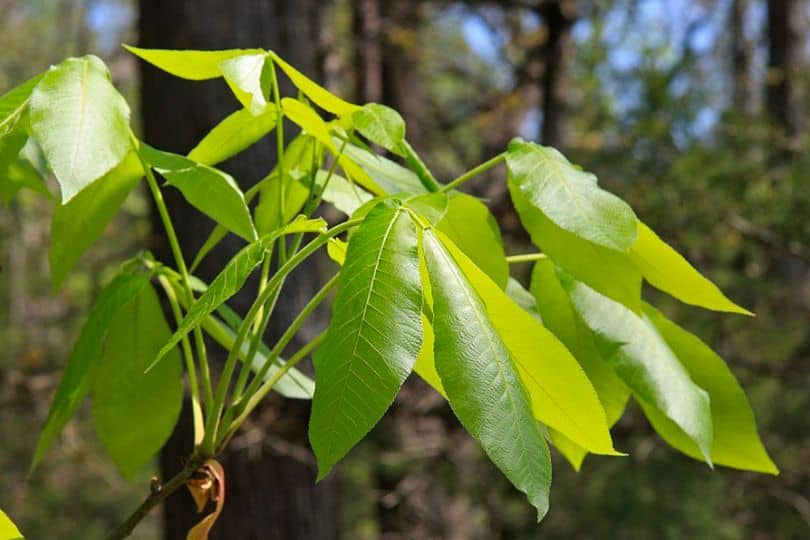
Carolina Hickory, also known as Southern Shagbark Hickory, is a deciduous tree that can reach a height of 60 to 80 feet and has a trunk 2 to 3 feet in diameter, with short, tiny branches forming a thin, oblong head. It is typically found in the eastern piedmont and mountains in low, flat forests and river bottoms.
Small, smooth leaflets and smooth petioles are characteristics of the Carolina Hickory. The fruit is tiny and shaggy, with a thick husk and a thin-shelled nut. The leaves are dark green and smooth on top and pale yellow-green, glossy, and smooth on the undersides. Petioles (stems) are smooth. The tree bears dark, red-brown fruits that are wider than they are long, ranging in size from 3/4 to 1 1/2 inches. The husk is about 1/8 to 3/8 inch thick and easily breaks at the base. The egg-shaped nut inside the husk is white or pale brown with a thin shell.
Carolina Hickory wood is firm, sturdy, and tough, as well as light and reddish brown. It is utilized for similar reasons as other hickory trees, and the tree’s nuts are of high quality and edible.
5. Sand Hickory
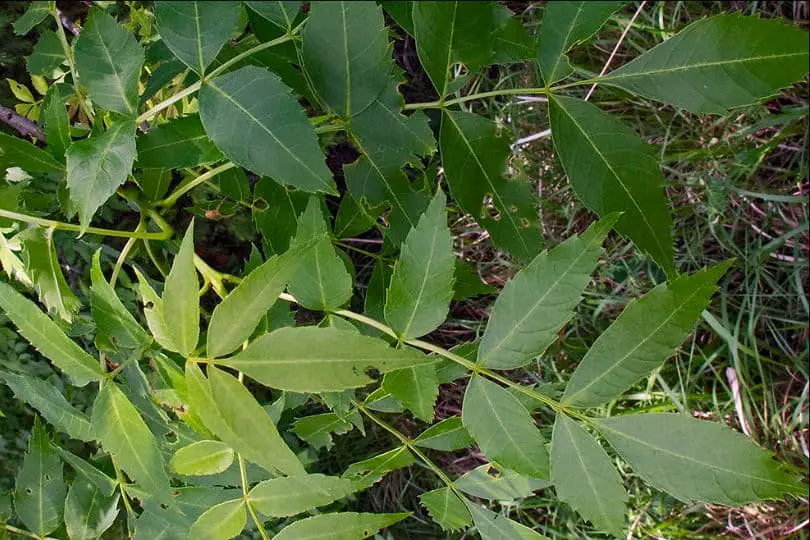
The Sand Hickory tree, also known as Pale Hickory, is a deciduous tree that may reach heights of 100 feet and has a trunk diameter of 2 to 3 feet. The tree’s compound leaves are 7 to 15 inches long, with 7 to 9 slender, long-pointed leaflets with toothed margins that shed in autumn. The top of the leaf is pale or silvery and hairy, while the bottom is pale or silvery and hairy. The petioles, or stalks, are likewise hairy.
The Sand Hickory tree is distinguished by its slender and long-pointed leaflets that are silvery and hairy beneath, as well as its hairy petioles and pear-shaped fruit covered in yellow scales. The fruit is pear-shaped and can develop to be 1/2 to 1 1/2 inches long. The fruit is hairy and covered in yellow scales, and the husk splits slowly towards the base to reveal a white and slightly ridged nut inside.
The bark of mature Sand Hickory trees varies depending on the tree’s vitality. Trees with vigorous growth have pale, slightly ridged bark, whereas trees with weak growth have a dark grey, almost black, and severely furrowed bark. The Sand Hickory tree has brown wood with almost white sapwood, but it is mostly used for fuel.
The Sand Hickory tree is mainly found on sandy soil and is only found in a few places across the state like the piedmont regions.
6. Shagbark Hickory
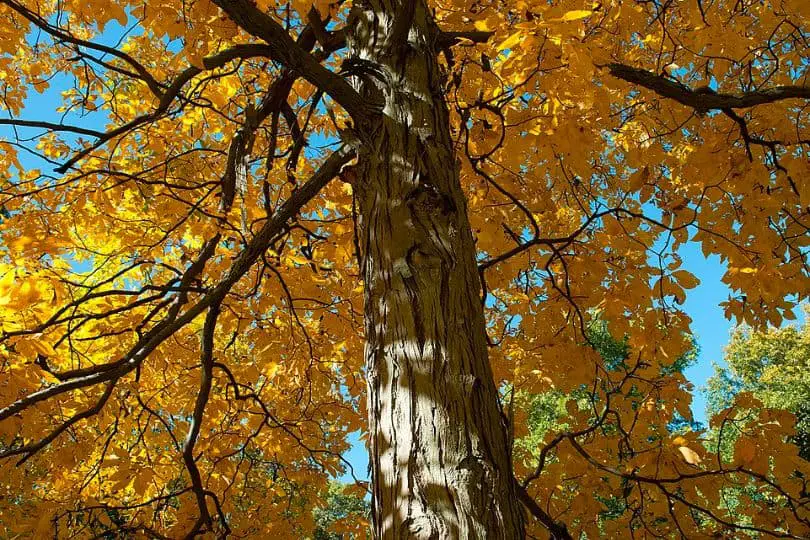
The Shagbark Hickory is a deciduous tree whose leaves fall in autumn. It has enormous compound leaves that are 10 to 17 inches long and have 5 to 7 ovate leaflets. The terminal leaflet is larger than the laterals, measuring 5 to 7 inches long and 2 to 3 inches wide. The leaf margins are serrated, and the upper surface is dark yellow-green and smooth, with a paler and hairier under surface. The leaf petiole, or stalk, is hairy.
The tree has nearly spherical fruit 1 to 2 1/2 inches long with a hull 1/8 to 1/2 inch thick. The nut is flattened with a thin shell and has four sides. The nut kernel has a delicious flavor. Shagbark Hickory bark is grey and separates into enormous flakes, frequently a foot or longer and 6 to 8 inches wide, giving it a shaggy appearance.
The Shagbark Hickory tree can reach heights of 70 to 80 feet and, on rare occasions, 100 feet. It has a 1 to 3-foot diameter trunk that ends in a thin head. The Shagbark Hickory is distinguished by its shaggy bark, big and hairy leaves, thick hull, and thin shell.
The Shagbark Hickory tree’s wood is thick, hefty, and extremely strong, making it resistant to abrupt shocks. The wood is light brown in tone with practically white sapwood. The tree can be used to make hammer and axe handles, car wheel spokes, wagons, agricultural implements, and fuel. It is very beneficial when smoking meat. Shagbark Hickory grows in low hills, near streams and marshes, and in fertile soils primarily in the southwest and north Georgia.
7. Pignut Hickory

The Pignut Hickory, scientifically known as Carya glabra (Mill.) Sweet, may reach heights of 60 to 90 feet, and has a trunk diameter of 2 to 2 1/2 feet. The tree’s branches are tiny, spreading, and frequently drooping, making a tall, narrow head. Pignut Hickory bark is light grey and close, with rounded ridges.
Pignut Hickory leaves are complex, 8 to 12 inches long, and usually comprise 5 slender leaflets (rarely 7). The upper surface of the leaves is yellow-green and smooth, as is the lower surface. The leaf stems, or petioles, are smooth. The terminal leaflet is usually larger than the laterals, and the leaflet margins are toothed.
The tree has fruits that are somewhat flattened, egg-shaped to almost spherical, and usually have a neck at the base. The fruit size varies but is normally approximately 1 inch long, with a thin (1/16 inch) hull that opens partially or completely. The nut is round or flattened, without ridges, and has a smooth, thick, or thin shell. Smooth petioles, small and smooth winter buds (about 1/3 to 1/2 inch long), small fruits, and smooth nuts with a thin hull that does not split freely are all characteristics of the Pignut Hickory.
Pignut Hickory wood is dense, hard, robust, resilient, and flexible, with a light or dark brown color and thick, lighter-colored sapwood. The tree, like other hickories, is used to make tool handles, agricultural equipment, and fuel. The Pignut Hickory grows in poor soils, usually on uplands, and is abundant in the state’s central region. It is also common in the coastal plain and, on rare occasions, in the mountains.
8. Shellbark Hickory
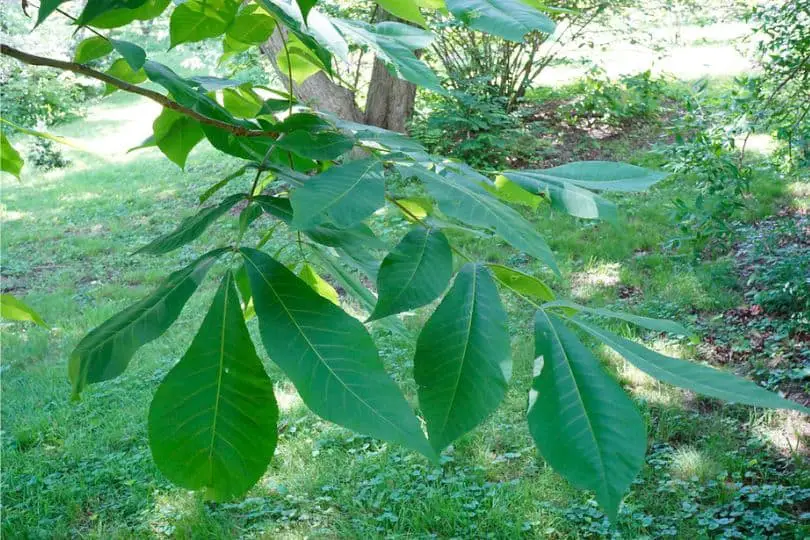
The Shellbark Hickory, also known as the Bigleaf Shagbark Hickory, is a deciduous tree with huge leaves that range in length from 15 to 22 inches and have 5 to 9 oval leaflets. The leaflets toward the tip are significantly bigger and have toothed borders than the others. The leaves are dark green, lustrous, and smooth on top, but pale yellow-green or brown and hairy on the undersides.
The tree bears light orange or dark chestnut brown spherical or egg-shaped fruits. The fruit is 1 3/4 to 2 1/2 inches long and has a 1/4 to 1/3 inch thick husk. The flattened nut inside the husk ranges in hue from bright yellow to reddish brown. The nut’s shell can be up to 1/4 inch thick.
The Shellbark Hickory’s bark is light grey and divides into broad, thick plates, giving the tree a shaggy appearance. The tree can grow to be 80 to 100 feet tall and has a 2 to 3-foot diameter trunk that ends in a narrow, oval head.
The large, hairy leaves of hickory and the petioles, or leaf stems, which remain on the branches for a long time, are its defining characteristics. The fruit is also enormous, with a thick husk and shell and shaggy bark.
Shellbark Hickory wood is heavy, hard, strong, durable, close-grained, and dark brown. It is utilized for similar uses as other hickory trees, and the tree’s huge nuts are delicious.
Shellbark Hickory is generally found in fertile bottom soils that are occasionally inundated. It is only found in Georgia’s eastern piedmont, notably Oglethorpe and Wilkes Counties.
Native Hickory Trees In Georgia – Frequently Asked Questions (FAQs)
In this section, I will be going through some of the most commonly asked questions related to native hickory trees in Georgia.
Are there hickory trees in Georgia?
Hickory is one of the most commonly seen trees in Southeastern states including Georgia. And, Georgia is home to several varieties of hickory trees like Bitternut, Red, Mockernut, Shagbark, Pignut, Shellbark, etc.
How to identify hickory trees in Georgia?
Even though different hickory trees in Georgia have unique traits that help you distinguish between them, certain characteristics are common to all of them which helps in identifying hickories in general.
Hickory trees have leaves that are slender and have jagged edges that grow from each stem. Although some leaves may have a rounder shape, most hickory leaves measure between 2-8 inches in length. The leaves of the hickory tree grow in pairs off the stalk, with between 2-9 leaves on each side and a single leaf at the end. The nuts of the hickory tree are enclosed in a double shell.
Similar Articles
- Native Oak Trees in Georgia
- Native Dogwood Trees In Georgia
- Native Pine Trees In Georgia
- Native Tupelo Trees In Georgia
- Native Maple trees In Georgia
- Native Willow Trees In Georgia
- Native Plum Trees In Georgia
- Native Magnolia Trees In Georgia
- Native Ash Trees In Georgia
- Native Elm Trees In Georgia
- Native Cottonwood Trees In Georgia
- Native Cedar Trees In Georgia
- Native Birch Trees In Georgia
- Common Purple Trees In Georgia
- Common Cypress Trees In Georgia
- Common White Flowering Trees In Georgia
Sources
The Regional Gardening team makes sure that the information in our articles is accurate by only using sources that are known to be trustworthy. Some of these sources are peer-reviewed journals from government agencies, well-known universities, and scientific research organizations.
- Georgia Native Plant Society
- College Of Agricultural & Environmental Sciences, University Of Georgia
- Native Plants Books, Georgia Native Plant Society
- Georgia Forestry Commission
- Native Plants Of North Georgia, University Of Georgia


